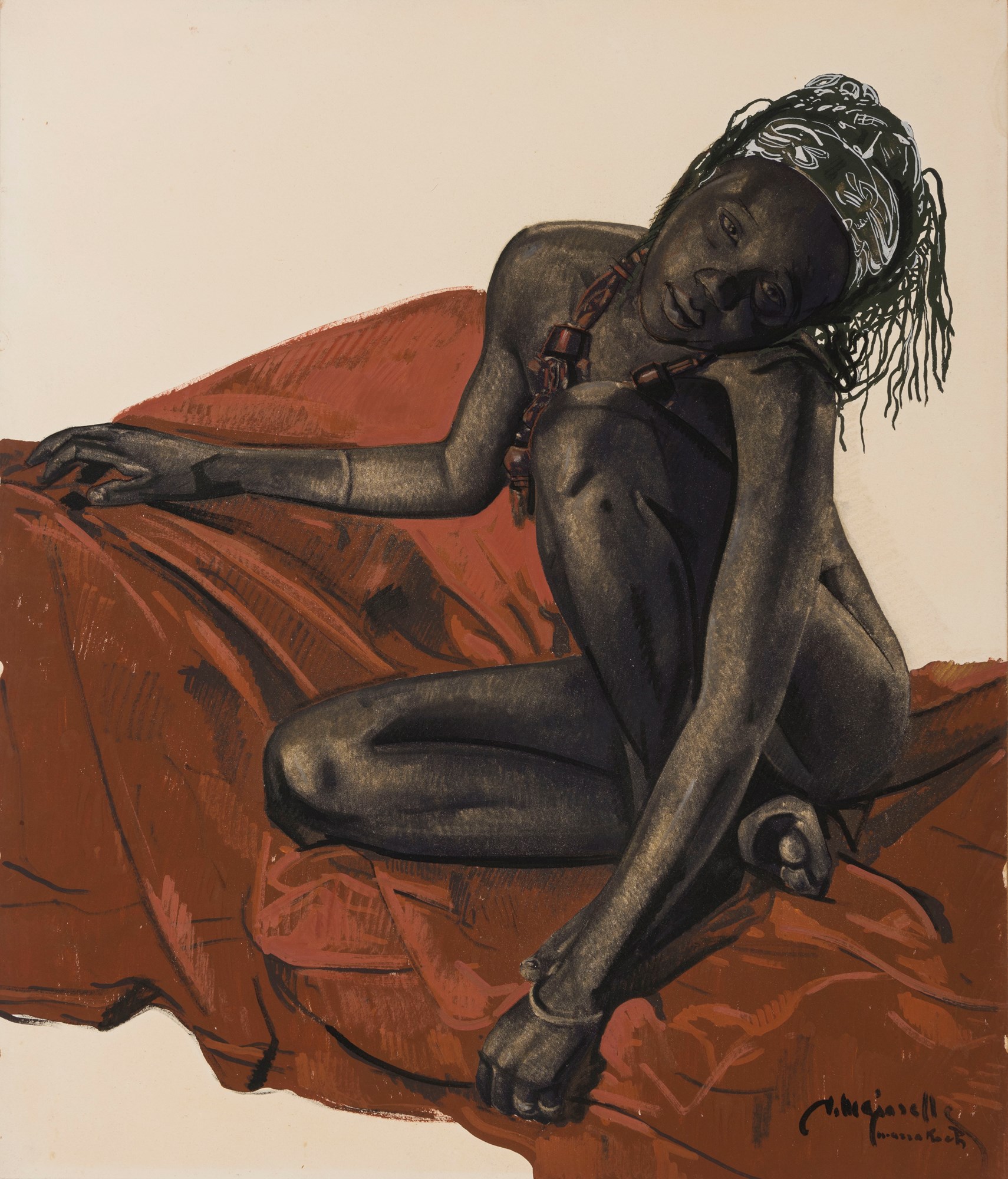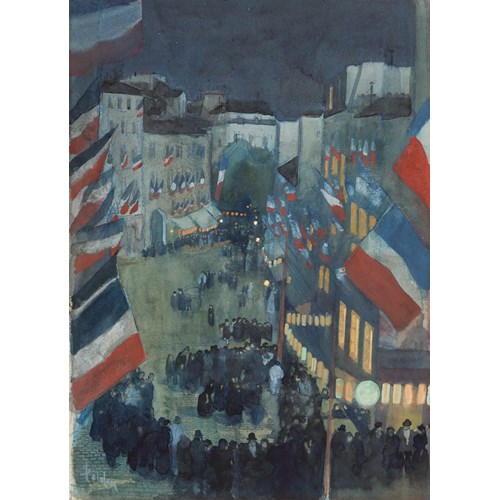Marketplace
Seated Female Nude
In the early 1930s Jacques Majorelle began to produce paintings and drawings of African female nudes, sometimes posed amid the luxuriant vegetation of the artist’s garden and at other times in a new studio that the artist had built adjoining the garden. As the Majorelle scholars Félix and Amélie Marcilhac have written, ‘Splendid greenery now surrounded the studio. Shielded from the social events and obligations that his wife always took on, the artist could at last withdraw and work at his painting without hindrance. It had become an entirely separate home, and was a place of personal retreat in which the artist could shut himself away for several days with his models, without going out, to paint them nude away from prying eyes and have them adopt languid, if not suggestive, poses.’
Previously only known from a black and white photograph published on the front page of a Casablanca newspaper in April 1934, the present sheet is a superb example of Majorelle’s nude studies. As Marcilhac has noted of drawings such as this, ‘Technically, in this new series of nudes, his material was reduced. He quite readily used large sheets of paper, sometimes tinted, that he covered in watered-down colours. He then added bright colours that he applied with a brush, mixing them with metallic powders or applying them tentatively on top with his fingers, to give them a more casual design. If the backgrounds were not often sketched out, the human figures, on the other hand, appeared extremely well done and realistic. In the foreground, lying down, sitting, dancing, working or sleeping, whether moving or still, these young girls always expressed an intense, natural joie de vivre that was almost savage…Splendidly rendering their gleaming skin using golden or violet pigments, gold or silver metallic powders mixed with other colours, the painter reproduced all the beauty of their bodies, and gave his compositions a startling impression of life.’ A closely related work on paper, of slightly larger dimensions and horizontal format and showing the same model in a very similar pose, is in a private collection.
The first owner of the present sheet was the French banker Paul-Eugène Sombsthay (1894-1964), a native of Alsace who had settled in Marrakesh not long after Morocco became a French protectorate in 1912. Serving as the director of the Crédit foncier d’Algérie et de Tunisie, Sombsthay befriended his fellow expatriate Majorelle and may have acquired this large work on paper directly from the artist in the 1930s. Included in an exhibition of Majorelle’s work held in April 1934 at the Galerie Derche in Casablanca, this superb drawing has not been exhibited in public since. As a contemporary newspaper account of the Galerie Derche exhibition, which was accompanied by an image of the present sheet, noted, ‘Majorelle has but one landscape painting. All the rest are unique pages of nudes showing African beauty and signifying its simple, childlike soul, with no distraction or over-thinking, this nude soul in full sunlight, with the gaiety and human sweetness of innocence.’
Previously only known from a black and white photograph published on the front page of a Casablanca newspaper in April 1934, the present sheet is a superb example of Majorelle’s nude studies. As Marcilhac has noted of drawings such as this, ‘Technically, in this new series of nudes, his material was reduced. He quite readily used large sheets of paper, sometimes tinted, that he covered in watered-down colours. He then added bright colours that he applied with a brush, mixing them with metallic powders or applying them tentatively on top with his fingers, to give them a more casual design. If the backgrounds were not often sketched out, the human figures, on the other hand, appeared extremely well done and realistic. In the foreground, lying down, sitting, dancing, working or sleeping, whether moving or still, these young girls always expressed an intense, natural joie de vivre that was almost savage…Splendidly rendering their gleaming skin using golden or violet pigments, gold or silver metallic powders mixed with other colours, the painter reproduced all the beauty of their bodies, and gave his compositions a startling impression of life.’ A closely related work on paper, of slightly larger dimensions and horizontal format and showing the same model in a very similar pose, is in a private collection.
The first owner of the present sheet was the French banker Paul-Eugène Sombsthay (1894-1964), a native of Alsace who had settled in Marrakesh not long after Morocco became a French protectorate in 1912. Serving as the director of the Crédit foncier d’Algérie et de Tunisie, Sombsthay befriended his fellow expatriate Majorelle and may have acquired this large work on paper directly from the artist in the 1930s. Included in an exhibition of Majorelle’s work held in April 1934 at the Galerie Derche in Casablanca, this superb drawing has not been exhibited in public since. As a contemporary newspaper account of the Galerie Derche exhibition, which was accompanied by an image of the present sheet, noted, ‘Majorelle has but one landscape painting. All the rest are unique pages of nudes showing African beauty and signifying its simple, childlike soul, with no distraction or over-thinking, this nude soul in full sunlight, with the gaiety and human sweetness of innocence.’
Provenance: Acquired from the artist in the early 1930s by Paul-Eugène Sombsthay, Marrakesh
Thence by descent.
Literature: La Vigie Marocaine, 4 April 1934, illustrated p.1
Félix Marcilhac and Amélie Marcilhac, Jacques Majorelle (1886-1962): Catalogue of work, Paris, 2023, p.144, p.289, no.55 (as location unknown, and dated c.1933-1934).
Exhibition: Casablanca, Galerie Derche, Jacques Majorelle, April 1934.
Plus d'œuvres d'art de la Galerie









